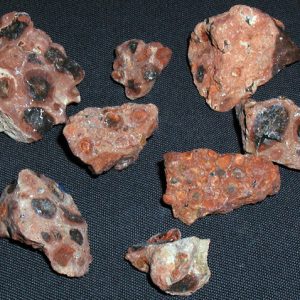calsfoundation@cals.org
Official State Rock
aka: Bauxite
Bauxite, the most common ore of aluminum, was designated the official state rock in 1967. It is a sedimentary material composed primarily of one or more aluminum hydroxide minerals, plus mixtures of silica, iron oxide, titania, aluminum silicates, and other impurities in minor or trace amounts. Bauxite takes its name from the village Les Baux de Provence in southern France, where geologist Pierre Berthier first identified it in 1821.
Bauxite was an economic mainstay for Arkansas through much of the twentieth century. Although aluminum is the second-most-abundant metal element in the world, it has been commercially produced for little more than a century. In 1891, state geologist John Branner identified a sample that had been found in southern Pulaski County in central Arkansas in 1887 as the aluminum ore. The first attempts to mine Arkansas bauxite commercially began eleven years later, inspiring the founding of a town, Bauxite (Saline County). The industry remained centered in Pulaski and Saline counties throughout its history.
Arkansas’s bauxite deposits proved to be the largest commercially exploitable deposits in the nation. Throughout most of the twentieth century, Arkansas remained the nation’s major bauxite producer, providing about ninety percent of all domestic tonnage mined. Thanks to innovations in refining, the availability of aluminum increased as its price declined; this led to increased use of the refined metal in such industries as construction, transportation, and the production of household goods.
Bauxite mining in Arkansas increased more slowly than national consumption because larger deposits supplying higher-grade bauxite were readily available in the Caribbean. But in the early stages of World War II, ships carrying bauxite to the United States suffered high losses to enemy submarines. It was imperative that increased domestic production supplement foreign supplies. The tonnage of bauxite mined in Arkansas quickly increased to meet wartime demands for aluminum, which was especially critical to the military aircraft industry. In 1943, more than six million long tons of bauxite were mined in the state. In 1967, the Arkansas General Assembly acknowledged the industry’s significance by designating bauxite as the Official State Rock. This designation was contained in an omnibus measure, Act 128, which also honored diamonds (Official State Gem) and quartz crystals (Official State Mineral). Act 128 was introduced as Senate Bill 143 by Senators J. Hugh Lookadoo, Robert Harvey, and Olen Hendrix. None of these senators represented major mining districts; rather, they asserted that it was essential that the General Assembly immediately designate a state gem, mineral, and rock in order that various interested clubs and individuals in Arkansas could trade them.
Because of changing domestic and world economic market conditions, demand for Arkansas bauxite fell in the last decades of the twentieth century. Small tonnages continued to be mined and used in the production of alumina-based materials, including chemicals and abrasives, as late as 1990.
For additional information:
Bachus, Gordon Scott. Written and Pictoral [sic] History of Bauxite. North Little Rock, AR: Heritage, 1968.
Bramlette, M. N. Geology of the Arkansas Bauxite Region. Little Rock: Arkansas Geological Survey, 1936.
Bush, William V. History of Bauxite in Arkansas. Little Rock: Arkansas Geological Commission, 1996.
Edwards, Junius David. The Immortal Woodshed: The Story of the Inventor who Brought Aluminum to America. New York: Dodd, Mead, 1955.
Smith, George David. From Monopoly to Competition: The Transformations of Alcoa, 1888–1986. New York: Cambridge University Press, 1988.
U.S. Department of the Interior, U.S. Geological Survey, U.S. Bureau of Mines. USGS Mineral Commodities Summaries 1998. Washington DC: U.S. Bureau of Mines, 2015. Online at: http://minerals.usgs.gov/minerals/pubs/commodity/bauxite/mcs-2015-bauxi.pdf (accessed August 3, 2023).
Ware, David. It’s Official! The Real Stories behind Arkansas’s State Symbols. 2nd ed. Little Rock: Butler Center Books, 2017.
David Ware
Arkansas Secretary of State’s Office
 Geography and Geology
Geography and Geology Bauxite, Official State Rock
Bauxite, Official State Rock  Robert Harvey
Robert Harvey 




Comments
No comments on this entry yet.